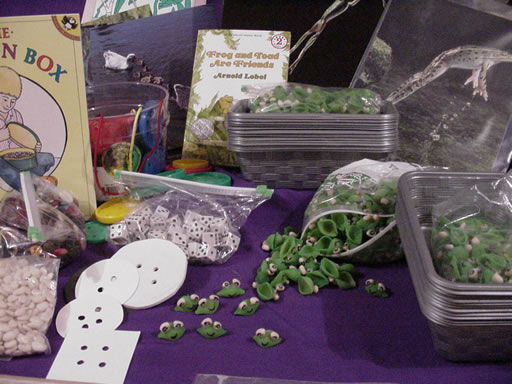| Description
| Educational Content | Contents
| Back to Available Trunks |
 |
Grade
Level: Elementary, K-2
|
Description:
|
| Frog
Math uses trade books and learning activities to give primary
students experiences with mathematics and science. The story
'Frog and Toad are Friends' begins the unit. Nonfiction books,
big books, and posters provide additional factual information.
The children participate in mathematical games and science discussions.
Some of the topics covered are graphing, place value, estimation,
probability, computation, creative writing, and group discussions
about frogs. |
| Designer:
Marty Belanger (Caribou Elementary School) |
| History:
Designed originally in 1998 using grant from Maine Math and
Science Alliance, copied for the Library in 2000 using an Eisenhower
grant. |
| |
Educational
Content
|
| The
Frog Math trunk was designed using the following guidelines
established by the Maine State Learning Results |
Mathematics Pre K -2
|
|
A. NUMBERS AND
NUMBER SENSE
|
| |
A1.
Demonstrate an understanding of what numbers mean.
A3. Order, compare, read, group, and apply place value concepts
to numbers up to 1000.
A4. Determine reasonableness of results when working with quantities. |
| |
B. COMPUTATION
|
| |
B3.
Show understanding of addition and subtraction by using a variety
of materials, strategies and symbols. |
|
C. DATA ANALYSIS
AND STATISTICS
|
| |
C2.
Make tallies and graphs of information gathered from immediate
surroundings. |
|
D. PROBABILITY
|
| |
D1.
Use concepts of chance and record outcomes of simple events. |
| |
E. GEOMETRY
|
| |
E1.
Describe, model and classify 2D shapes and selected 3D figures. |
| |
I. DISCRETE MATHEMATICS
|
| |
I1.
Classify sets of objects into two or more groups using their
attributes.
I2. Create and use an organized list to determine possible outcomes
or solve problems. |
| |
J. MATHEMATICAL
REASONING
|
| |
J2.
Distinguish between "important" and "unimportant"
mathematical information. |
| |
K. MATHEMATICAL
COMMUNICATION
|
| |
K1.
Use numerals and symbols to report numerical data and relationships.
|
| |
|
English Language Arts Pre K - 2
|
| |
A. PROCESS OF READING
|
| |
A1.
Seek out and enjoy experiences with books and other print materials.
A2. Demonstrate an understanding that reading is a way to gain
information about the world
A7. Ask questions and give other responses after listening to
presentation by the teacher or classmates. |
| |
B. LITERATURE
AND CULTURE
|
| |
B1.
Understand the basic plot of simple stories.
B2. Draw logical conclusions about what will happen next or
how things might have turned out differently in a story. |
| |
E. PROCESSES
OF WRITING AND SPEAKING
|
| |
E1.
Tell about experiences and discoveries, both orally and in writing.
E2. Respond to stories orally and in writing.
E3. Respond to remarks or statements orally and in writing. |
| |
G. STYLISTIC
AND RHETORICAL ASPECTS OF WRITING AND SPEAKING
|
| |
G1.
Dictate or write stories or essays that convey basic ideas have
sequences that make sense, and show evidence of a beginning,
middle and ending.
G7. Ask questions and give other responses after listening to
presentations by the teacher or classmates. |
| |
Contents
|
|
Notebook: MSLR support, lesson plans, assessment, etc.
Videos: None
Books & Publications:
- "Frog
and Toad are Friends"; Arnold Lobel; Harper Trophy,
1970; ISBN 0-06- 444020-6 (pbk)
- "The Button
Box"; Margaret S. Reid; Puffin Unicorn, 1990; ISBN
0-14-055495-5
- "Leaping
Frogs"; Melvin Berger; Newbridge Educational Publishing,
1995; ISBN 1- 56784-023-X
Posters:
- 1-large, 8-sm
life cycle Leaping Frogs (1 poster in Ziplock bag)
- 8-sm water
animals Life in a Pond (2 posters in Ziplock bag, teachers
guide)
- 25 small -
(graphs for hundreds, tens, ones)
Objects:
Individual
bags:
- 3 bags- macaroni
frogs with eyes (many)
- 2 bags- mixed
buttons
- 1 bag - dice
- 1 bag - lima
beans
- 1 bag - 5 magnetized
paper buttons black & white
|
| . |
 |